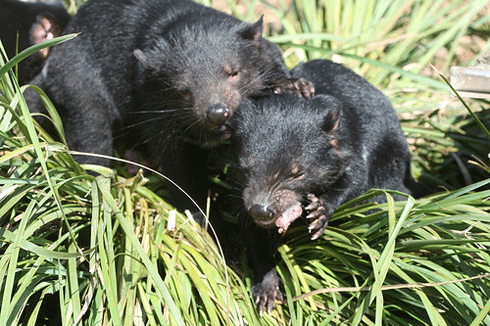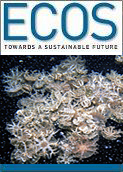
|
Published: 3 September 2012
Dismay as Tassie devil disease revealed to be immortal
New research has revealed that devil facial tumour disease (DFTD), which has already decimated 85 per cent of the devil population, is not weakening with time, making captive breeding and a vaccine urgent priorities to preserve the species.

|
|
DFTD is a naturally occurring contagious cancer transmitted between devils when they bite each other. It reproduces through the cloning of its cells. Credit:
Arthur Chapman. Licensed under a Creative Commons Attribution Non-Commercial Share-Alike 2.0 Generic License
|
Since its appearance in 1996, DFTD has killed in excess of 100,000 animals and gone through billions of cell divisions, so some deterioration of the cell line might have been expected.
The research has been published in a paper in the journal PloS One.
‘The scientific community trying to address the disease hoped it was slowing down or would show signs of slowing down, but this research proves it is not doing that and is more likely to get stronger,’ says lead author Dr Kathy Belov, of the University of Sydney.
‘We have discovered that DFTD is able to survive indefinitely because the ‘caps’ at the ends of their chromosomes are being replenished, essentially preventing ageing in this cell line.’
‘Amazingly DFTD is replicating itself just as fast as ever. Our results confirm that DFTD represents one of the oldest naturally living, and continuously transferred cell lines in nature,’ says co-author and postdoctoral research fellow at the University of Sydney Dr Beata Ujvari.
The research looked at telomere changes over time in DFTD cells. Telomeres are repeated sequences on the ends of chromosomes that have been compared to the protective plastic on the end of a shoelace.
In the same way, the primary role of the telomeres is to protect the end of the chromosomes from fraying. During normal cell division telomere length shortens until a critical length is reached, at which point the cell can no longer divide.
In human cancer cells telomeres do not get shorter but are maintained by an enzyme called telomerase.
‘Similarly we have now confirmed that in DFTD cancer cells the telomeres were also maintained by the telomerase enzyme so the cells can divide without limit,’ Dr Ujvari says.
‘The confirmation of the mechanism did not surprise us, given its existence in humans, but the longevity and stability of the disease is surprising and at this point, the revelation that DFTD cells are immortal is demoralising.’
In fact the researchers discovered that both the length of the telomere and the activity of the telomerase have been increasing over time in the devils. Future studies will need to test if this leads to an increased rate of cell division.
‘In the meantime we need to redouble our efforts to protect this species from extinction. We have found that the tumour is not going to die out, meaning that our major hope at the moment lies in removing the devils from the path of DFTD. The captive breeding program is essential to save this iconic species from disappearing completely,’ says Dr Ujvari.
Source: University of Sydney



